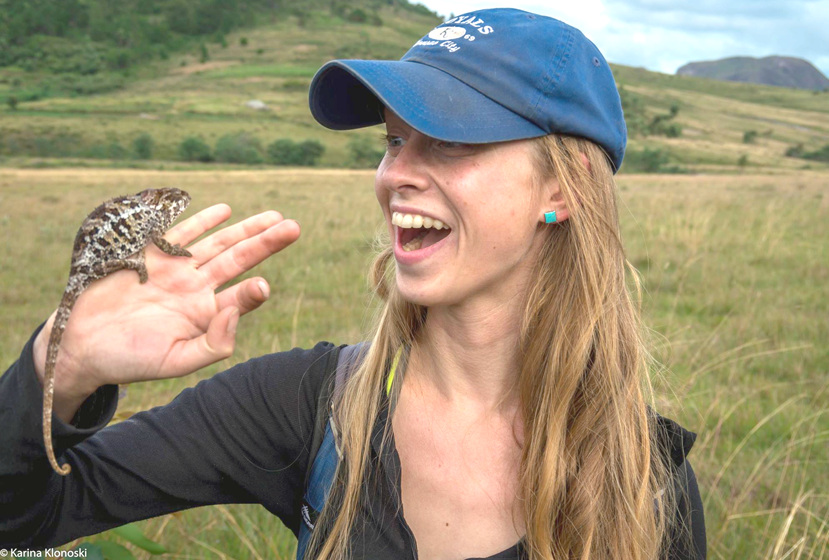
In 1980, astrophysicist Carl Sagan introduced people around the world to the possibilities of astrobiology - a scientific field dedicated to the search for life beyond our lonely blue planet - with a television series, Cosmos: A Personal Voyage. Wearing a scholarly beige jacket, Sagan traversed the universe, drawing viewers on a journey across the vastness of space and reviving interest in a question that had been brewing within humanity’s collective psyche since the beginning of civilization - has life arisen elsewhere in the Universe? With the maturation of space technology during the latter half of the 20th century, it finally became possible to begin a substantive investigation, but the road through astrobiology has not been without its rough stretches. Despite the revolutionary implications that astrobiology holds for humankind, scientists engaged in the search have occasionally encountered political and financial challenges. Through it all, UC Berkeley scientists scattered across numerous departments have been pursuing answers to some of the most profound questions our species has ever asked - what is life, how did it evolve, and are we alone?
Are we alone?
A committed quest to discover extraterrestrial life began in the 1960s with the birth of SETI (Search for Extraterrestrial Intelligence), a scientific field dedicated to scanning the sky for signals released into space by intelligent civilizations. Excited by SETI’s potential for discovery, on Columbus Day in 1992 NASA dedicated $100 million to the endeavor, but rumblings within Congress about overspending soon made NASA reconsider its commitment. Targeted as an example of wasteful spending and mocked as the “search for little green men,” SETI lost NASA’s financial support, forcing researchers around the country to find other avenues for funding their work. “We all started scrambling around,” says SETI at Berkeley chief scientist Dan Werthimer, “but we got some private support, companies gave us money, and so we were able to keep going, keep innovating.”
Despite the occasional setbacks, Berkeley’s SETI scientists have become pioneers in technological development and astronomical research. The scope of their creativity is reflected in their research programs - each with a different approach to tapping into the interstellar communications of distant civilizations - currently run by SETI at Berkeley. While they vary in their specific approaches, most of the projects work on the assumption that intelligent civilizations are emitting electromagnetic radiation into space, either intentionally to communicate with other intelligent beings, or accidentally as a byproduct of their daily lives. Electromagnetic radiation of varying energies corresponds to different types of detectable signals - radio waves, infrared waves, and visible light waves, to name a few. While waves from the entire electromagnetic spectrum are emitted by non-biological sources in the universe (radio waves, for instance, can be produced by stars and gases), SETI researchers argue that a concentrated, sustained, and repetitive release of waves from a narrow portion of the spectrum would suggest the presence of intelligent life. “We look for things that the universe doesn’t produce naturally,” says Andrew Siemion, a SETI graduate student from the Department of Electrical Engineering and Computer Sciences. “It can be a lot of energy in a very narrow time window, or a lot of electromagnetic energy in a very narrow frequency window.”
At the lowest end of the spectrum are radio waves, which were among the first to be scanned by SETI scientists for signs of alien intelligence, in part because they travel through space relatively unimpeded. One of SETI’s largest and longest-running radio-based research programs is UC Berkeley’s SERENDIP (Search for Extraterrestrial Radio Emissions from Nearby Developed Intelligent Populations), which began sifting through radio waves for signs of intelligent life over 30 years ago. In 1992, SERENDIP was installed at the Arecibo radio telescope, the largest and most sensitive radio telescope in the world, located in Puerto Rico. Like other radio telescopes, Arecibo works by gathering radio signals with an enormous curved dish lined with mirrors. When the signals bounce off of the dish, they’re directed toward a receiver, which collects the data and sends it along to researchers.
While the vast majority of SETI studies focus on narrow portions of the electromagnetic spectrum or on specific regions in space, SERENDIP takes a broader approach. “We try to look across the spectrum in the sense that we look at very long and very short wavelengths,” says Siemion. Werthimer adds, “There are different strategies in SETI. One of them is to find nearby stars that are kind of like our sun, point your telescope there, and look very carefully at that star. Our strategy typically is not to do that. We scan the sky, back and forth, looking at billions of stars, billions of galaxies.” While these tactics allow SERENDIP to search greater swathes of space and a wider portion of the electromagnetic spectrum, they have pitfalls - each region of space cannot be searched in fine detail, and with the influx of massive amounts of data, the system can only save the strongest signals for analysis, while the remaining majority of the data must be discarded. Berkeley’s SETI researchers responded to the latter challenge by creating SERENDIP’s complementary sibling project, SETI@home, which also collects data from the Arecibo radio telescope. While SERENDIP takes a rough look at a broad section, or bandwidth, of radio frequencies, SETI@home scans a much smaller bandwidth in exquisite detail, allowing it to pick up weak radio signals. The data collected by SETI@home are sent out in small chunks around the world to millions of personal computers, which process the data while they’re idle. Once finished, each computer sends its data back to SETI@home and receives a new data set to process. Since its inception in 1999, SETI@home has become the largest and most powerful supercomputer in the world, which has allowed it to facilitate the most sensitive SETI search in history.
Our microscopic neighbors
 Lake Tyrrell, a hypersaline lake in southeastern Australia.
Lake Tyrrell, a hypersaline lake in southeastern Australia.
While SETI researchers seek signs of macroscopic, intelligent life beyond our solar system, other scientists at UC Berkeley are hoping to find microscopic organisms on our neighboring planets and moons. In the Department of Chemistry, Professor Richard Mathies’ group is developing the next iteration of the Mars Organic Analyzer (MOA), a miniaturized biochemical analyzer system with the ability to detect a variety of organic molecules with significant roles in life processes. The lab is especially interested in using the MOA to search for amino acids - the building blocks of proteins - on Mars, since the chiral structure of these molecules can provide additional information about the presence or absence of life. Two molecules are said to be a chiral pair when they’re mirror images of one another, asymmetrical, made of the same constituent elements, and non-superimposable (for an illustration of chirality, look at your hands - this is why chirality is also known as “handedness”). All known life on Earth uses left-handed amino acids. No one knows exactly why this is the case, but scientists agree that a mixture of left- and right-handed forms would probably interfere with biological processes, since combining the two types of amino acids creates a misshapen, tangled mess of a protein. In contrast, homochiral (all left-handed or all right-handed) amino acids can be strung into a well-defined and functional protein capable of carrying out life-sustaining reactions. When they’re not being manipulated by organisms, amino acids tend to exist in a nearly equal mixture of left- and right-handed forms, a state known as heterochirality. With the MOA, an instrument compact enough to fit on a Mars-bound rover, but powerful enough to discern the presence and chirality of amino acids, future missions to Mars could determine if the planet harbors concentrated amounts of either left-handed or right-handed amino acids. A sample with a preponderance of either type of amino acid would suggest the presence of life and probably send more than one champagne cork flying into a laboratory ceiling.
In the field, the MOA separates out organic molecules using a microfluidic device, or chip (see “Lab on a chip,” BSR Spring 2009), which allows researchers to determine the make-up of a solution using a sample as small as one microliter (to give you an idea of how small that is, consider that it would take nearly 5,000 microliters to fill up one teaspoon). Similar in diameter to a Petri dish, the chip consists of a flexible membrane sandwiched between two glass plates. Etched into the glass are separation channels and holes, each corresponding to a valve that allows scientists (or a machine) to move a sample around on the chip using pressure and vacuums. To identify the molecules within a sample, the MOA begins by passing an electric current through the microfluidic device. Since many organic molecules carry different charges, the current causes them to move down the separation channels at different rates, depending upon their charge-to-size ratio. At the end of the line, the molecules, which have been tagged using a fluorescent label, pass over a laser and fluoresce. A spectrometer then analyzes the signal and produces a spectrogram (a sort of identification key) for each molecule. “Basically, it’s like being on a conveyor belt at an airport,” says Mathies Lab staff scientist Tom Chiesl. “Sometimes you get people that run forward on it, and other people want to go backwards, and some just sit there. Every different type of amino acid is moving at a different rate on a different type of conveyor belt. At the very end, they go by the laser and they fluoresce and then we see the signal.”
Until recently, the MOA had “flight status” designation, which essentially meant that the instrument was on the cusp of being installed on the upcoming ExoMars mission, a joint endeavor between NASA and the European Space Agency (ESA). With an intended launch date of 2018, the mission’s goals are to search for signs of past or present life on Mars and to study the planet’s geochemistry. During the planning process, officials at ESA were mulling over three different rover design options - large, medium, or small - and the respective benefits (bigger means more space for more instruments) and drawbacks (bigger means higher cost) of each. In the end, the economic downturn made the decision for them - ESA decided to proceed with the least expensive design, which placed real estate on the rover at a premium. With the need to include instruments built by European labs, ESA “descoped,” or bumped, the MOA from the 2018 mission. Despite this setback, Mathies lab staff scientist Tom Chiesl and graduate student Amanda Stockton are moving forward with their work and continue to envision an instrument that will eventually be more compact, lightweight, and someday get its first taste of Martian soil.
Unraveling the history of life
[caption id="attachment\\_8037" align="alignright" width="286"][](http://sciencereview.berkeley.edu/wp-content/uploads/2013/04/features\_05\_03\_jamesbond.jpg)Located in Puerto Rico, the Arecibo radio telescope provides data for SETI at Berkeley’s SERENDIP and SETI@home projects. With a diameter of 300 meters, the dish would hold ten billion bowls of corn flakes.
This article is part of the Spring 2010 issue.



